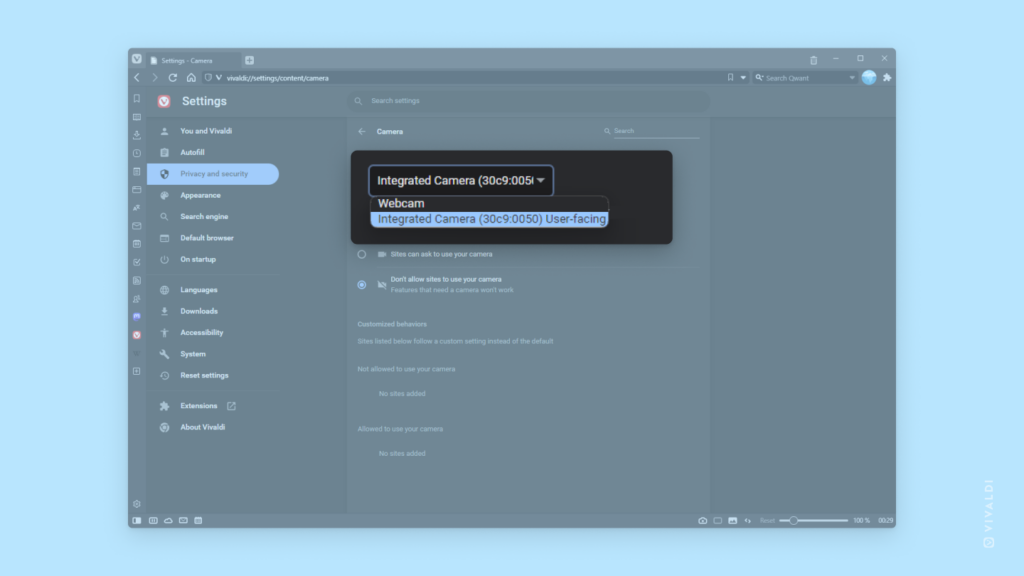Desktop Tips
Tip #248
April 3, 2023
Hibernate tabs to reduce Vivaldi browser’s memory usage.
Websites these days can be big and use a significant amount of resources. Closing tabs is a good way to reduce memory use, but what if you need to keep the tabs around and don’t want to close them? Hibernating tabs is a good alternative to both keep the tabs open and reduce the browser’s memory usage.
To hibernate a tab:
- On the Tab Bar or in the Window Panel, right-click on a background tab or Tab Stack.
- Select Hibernate Tab from the context menu.
To hibernate all background tabs:
- Right-click on any tab on the Tab Bar.
- Select Hibernate Background Tabs from the context menu.
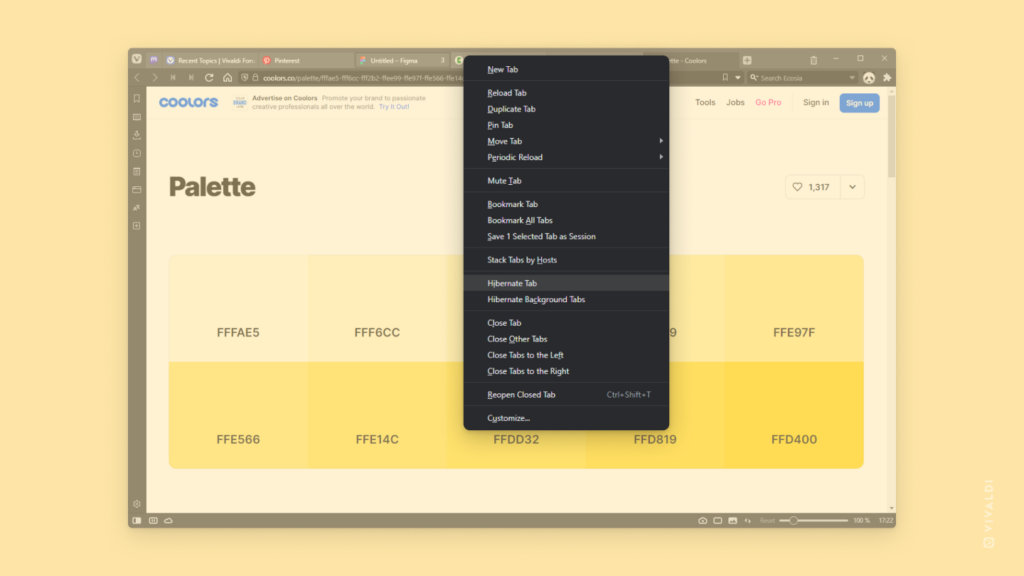
Tip #245
March 29, 2023
Show Start Page navigation menu on all internal pages.
By default the navigation menu on Start Page is only shown with your Speed Dials. But it can also be displayed when viewing Bookmarks, History, Notes, and Calendar.
To enable the menu:
- Go to Settings > Start Page > Start Page Navigation.
- Enable Show on Internal Pages.
Alternatively, you can hide the menu altogether by selecting Hide Titles in Start Page Navigation settings.
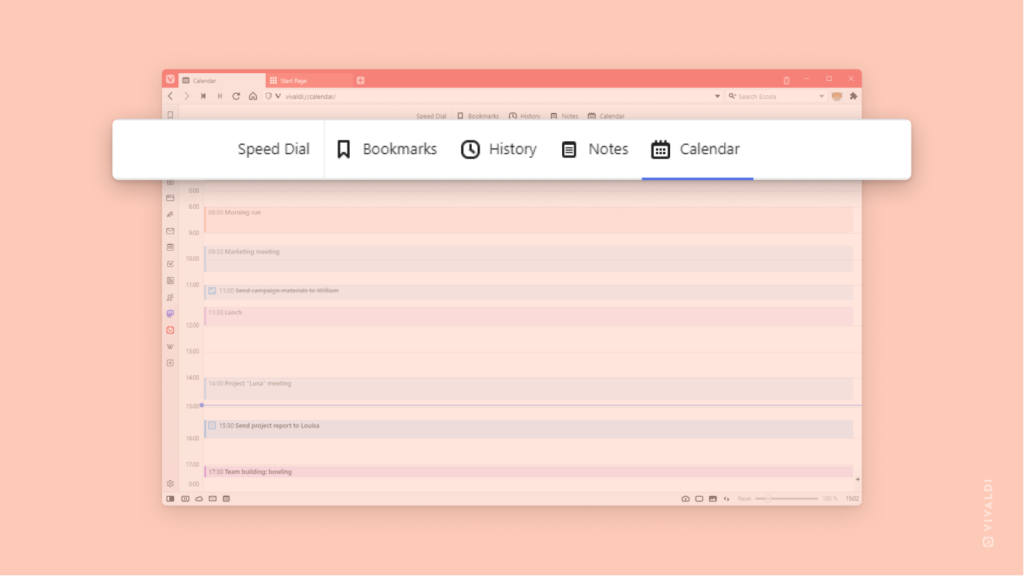
Tip #244
March 28, 2023
Use Quick Commands to export Notes.
Making notes as you browse is easy in Vivaldi with the Notes feature. But did you know that you can export notes as individual text files?
To export your notes:
- Create a folder for the notes in your File Manage/Finder.
- In Vivaldi, open Quick Commands (
F2/⌘E). - Type in “Export Notes” and press
Enter. - In the save dialog, locate and select the folder.
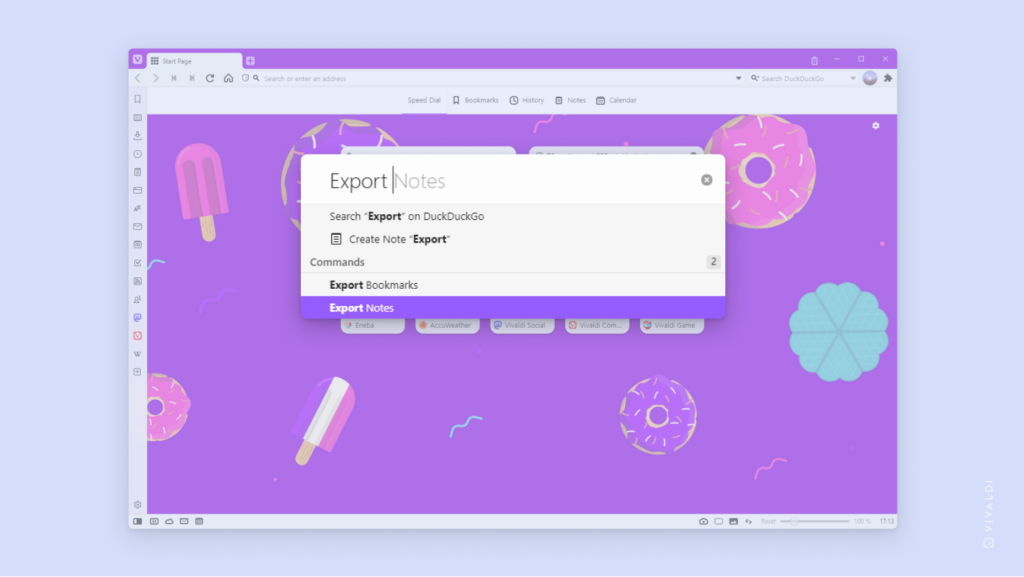
Tip #243
March 27, 2023
Keep a group of stacked tabs around by pinning the Tab Stack.
Pinning tabs prevents the tabs from being accidentally closed and you’ll always find them from the same location on the left side/top of the Tab Bar. In addition to pinning single tabs, in Vivaldi, you can also pin a Tab Stack.
To pin a group of tabs:
- Create a Tab Stack with the tabs you want to pin as a group.
- Right-click on the Tab Stack, either on the Tab Bar or in the Window Panel.
- Select Pin Tab Stack.
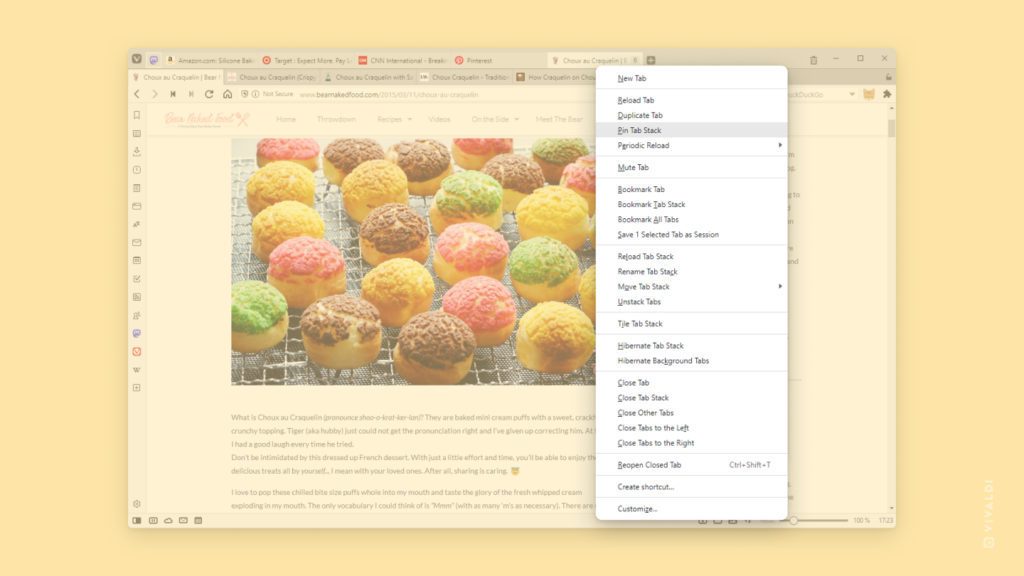
Tip #242
March 24, 2023
Bookmark multiple pages at once using the Tab context menu.
While browsing the internet, have you opened many web pages that you want to save for later as Bookmarks? In Vivaldi, there’s a way to add them all at once.
To add multiple web pages as Bookmarks:
- On the Tab Bar or in the Window Panel, select the tabs you want to bookmark while holding down the
ShiftorCtrl/⌘key. - Right-click on one of the selected tabs.
- Select Bookmark # Tabs.
In case you want to save all open tabs as bookmarks, select Bookmark All Tabs from the context menu.
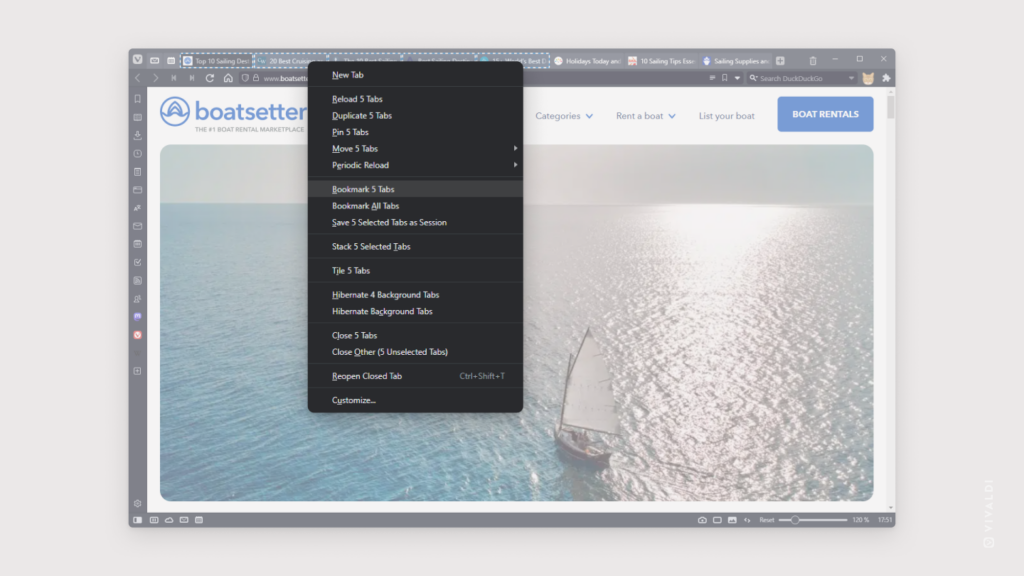
Tip #240
March 22, 2023
Middle mouse click on the Reload button to duplicate the active tab.
Do you quickly want to make a copy of the tab you have open in front of you, including all its history? Then all you need to do is click with the middle mouse button (scroll wheel) on the Reload current page button and it will open an exact clone of the tab you have open.
Then you can continue browsing in one of the tabs while staying at the place you need in the other.
Tip #238
March 20, 2023
Hide or move the close button to prevent accidental closing of tabs.
Vivaldi is all about giving you options, so you can make Vivaldi look and behave exactly the way you want it. In this tip will tell you a little about what you can do with regards to closing tabs.
When you go to Settings > Tabs > Tab Display > Tab Options you can make adjustments to the Close Tab button. You have the following options:
- Hide the button completely by disabling Display Close Button. In addition to the Tab Bar, it will also hide the button in the Window Panel.
- Choose whether to display the button on the left or right side.
- Permanently show the close buttons instead of just on hover. Note that it leaves less space for tab titles.
If you have chosen to hide the close button, you can close tabs in one of the following ways:
- Right-click on a tab and select Close Tab.
- Enable double-clicking on a tab to close it in Settings > Tabs > Tab Handling.
- Use the Keyboard Shortcut
Ctrl + W/⌘W. - Perform a Close Tab Mouse Gesture by holding down the right mouse button and drawing an L shape.
- Type “Close Tab” in Quick Commands.
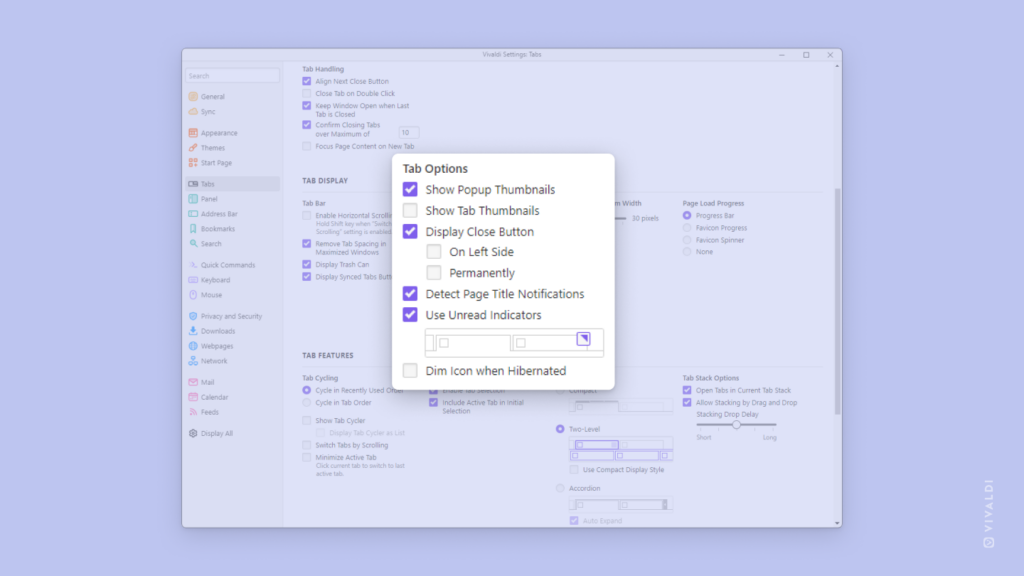
Tip #237
March 17, 2023
Reload pages with a right-click and up-down mouse movement.
Locating the reload button on the toolbar and moving the mouse to it takes time, so does finding the right key on your keyboard. Making a quick mouse movement while holding down a button your finger is already likely on – less than a second.
To reload a page with a Mouse Gesture:
- Hold down the right mouse button.
- Move the mouse up a bit and then down again.
- Release the mouse button.
Tip #236
March 16, 2023
Group all tabs from the same domain into one Tab Stack with just two clicks.
Have you gone down a research rabbit hole and now have too many tabs from the same website open? Tab Stacking helps to keep better track of these tabs.
To group tabs from the same domain into one stack:
- Right-click on one of the tabs on the Tab Bar or in the Window Panel.
- Select Stack Tabs by Host (# of example.com).
If you have opened multiple tabs from several websites, try grouping them by domain all at once by following Tip #156.
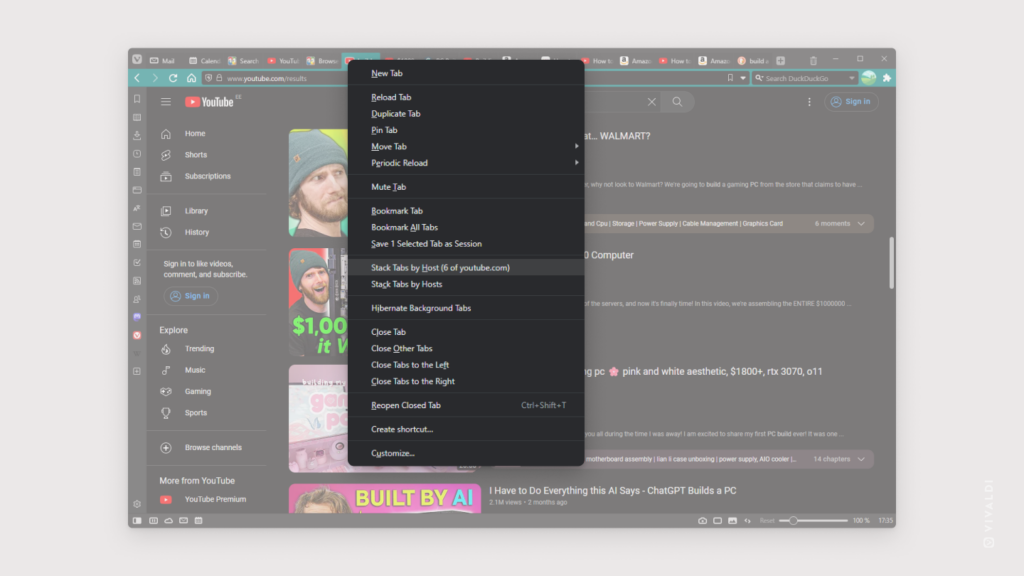
Tip #235
March 15, 2023
Press Tab followed by Space to mark a selected task as done without opening it.
When browsing through your tasks in the full window Calendar view or in the Tasks Panel or Calendar Panel, to mark a task as done, you can tick the box with a mouse click. But there’s also an easy way to do it when you have both hands on the keyboard.
To mark a task done:
- First, navigate to the task using arrow keys.
- When you’ve selected a task, press
Tabto focus on the task’s checkbox. - Then press
Spaceto tick the box.
Tip #234
March 14, 2023
Start every browsing session with the same set of tabs.
Most people prefer to continue were they left off the last time they used the browser, but if you have a different workflow, use Vivaldi Settings to make the browser open up with the set of tabs you want.
To start the browser with the same tabs every time you open it:
- Go to Settings > General > Startup with.
- Select Specific Pages.
- In the Startup Pages section that appears, enter the links of web pages you want to open.
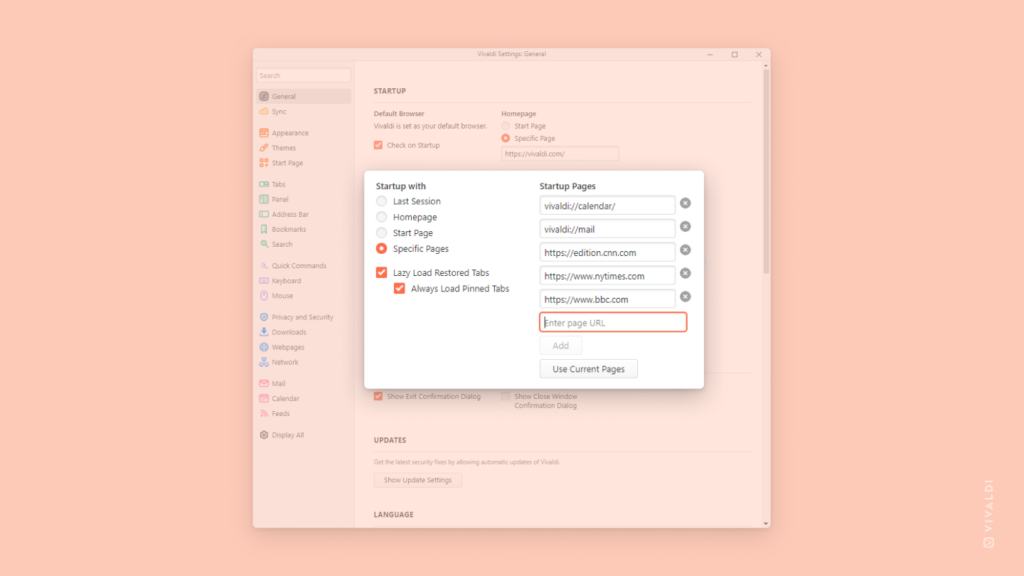
Tip #231
March 9, 2023
Change the default web camera used by websites in Vivaldi browser.
If you regularly join video calls via your browser, but have multiple web cameras attached to your computer (e.g. laptop’s built-in camera and an external camera), you can choose which one websites use by default.
To review and update camera settings:
- Paste
chrome://settings/content/camerato the Address Field and press Enter. (Yes, it’s supposed to say chrome.) - Click on the currently used camera’s name to see and select other available options.
